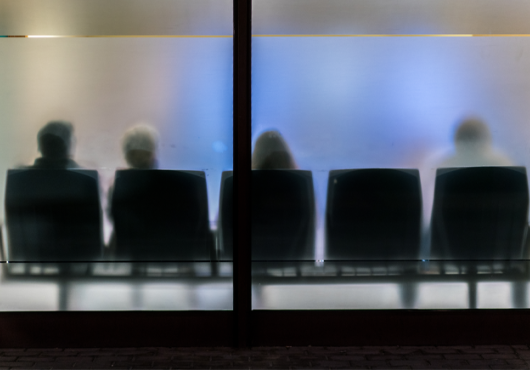Building a team isn’t easy. Some people don’t follow the rules while others are sticklers. Some carry their weight while others slack off. But good teamwork, with everyone pulling together, occurs at the very core of our being when the cells in our bodies cooperate to keep us alive.
Researchers have been working for more than a century to figure out how cells collaborate. They want to know, for instance, how cells move as a collective to heal wounds and to form organs, two fundamental yet still mysterious biological processes.
It is easy to watch basic cellular teamwork in action. A cluster of cells will creep across a dish with little prodding (see image and video below). Until now, however, researchers lacked the tools to tell if a few leader cells pull the others along, if new cells push others forward, or if each cell is like a soldier marching to a set program.
The answer, according to new work from Jeffrey Fredberg, HSPH professor of bioengineering and physiology, is “none of the above.” Rather, cells in an advancing cluster engage in a global tug-of-war, each one driving itself and, at the same time, pulling on and being pulled by its neighbors. The discovery, published online May 3 in Nature Physics, hinges on new technology from Fredberg’s lab that enables, for the first time, measurement of the forces behind this collective motion. The findings may help researchers fuse the study of physics with the study of biochemistry to better understand basic biology.
Fredberg, who is an engineer by training and a physicist in practice, specializes in developing technologies that measure physical forces on cells. In 2007, he and first author Xavier Trepat, then a research fellow, had just showed that cells behave like soft glassy materials (see Focus, June 8, 2007) and were looking for a new project. Trepat stumbled upon work speculating about how cells move as a group. He noticed, however, that the evidence relied on inadequate and sometimes nonexistent measures of force.
“I thought, even if we don’t know much about the biological problem, some of our technologies could be valuable,” said Trepat, who is now an assistant professor at the Institute of Biotechnology of Catalonia at the University of Barcelona.
Trepat planned to use a technique called traction force microscopy, which measures the forces cells exert on a gel as they travel across it. These forces are in the range of a nanonewton, he said, “a billion times smaller than the weight of the apple that fell on top of Newton’s head.”
But the technique’s precise measurements and complex computations worked only for single cells in isolation rather than for sheets of cells, such as those moving together as a developing organ or an invasive tumor. To apply the technology to a migrating collective, Trepat and Fredberg had to pull in co-author James Butler, HSPH senior lecturer on physiology, to untangle the mathematics and devise new, multicellular computations.
Butler succeeded and, with the upgraded technique in hand, Trepat and Fredberg measured the forces produced by individual cells in a migrating collective. Previously, scientists had only measured these forces at the leading edge of cell sheets and with much lower resolution, said Nir Gov, a professor of chemical physics at the Weitzman Institute of Technology in Israel who studies the theoretical physics of living matter.
Using just these novel force measurements, the researchers ruled out the theory that leading edge cells pull a sheet of cells forward like an engine pulling a train of passive “wagons.” “We saw that each wagon is also generating propelling forces,” said Trepat.
To get a more complete understanding of the intercellular forces, the researchers applied Newton’s laws of motion. Newton’s second law implies that there must be forces counteracting the measured forces, creating a balance across the collective. When Fredberg and Trepat calculated this balance, they saw that the stresses in the cell sheet rise as distance from the edge increases, implying that the cells mechanically transmit forces from cell to cell the same way stresses are transmitted along a rope in a tug-of-war.
This analysis rules out the hypothesis that cells advance independently, like marching soldiers, and it also contradicts the idea that cell proliferation pushes the sheet forward. If this were the case, the sheet would not be in tension, as in a tug-of-war, it would be under compression, similar to the way it feels to be in a crowded subway train.
In lieu of these longstanding models, Fredberg and Trepat propose a new hybrid model in which the cells are stuck together, and each individual cell both drives the collective motion and mechanically transmits tugging forces to its neighbors.
These findings help close the gap between cellular motion and biochemistry. With the ability to measure cellular forces, researchers can test how these forces influence intercellular signaling and vice versa. “Scientists will be able to go from molecules to forces to motion to provide a full picture of what’s going on,” said Trepat, who plans next to determine if cells besides the canine kidney epithelial cells he studied here exhibit the same tug-of-war behavior.
Meanwhile, Fredberg will continue to use the tools of physics to probe the material nature of living matter. “Some of the most important things we’ve done are not the ideas—although the ideas are important—but developing the methods that show things that no one anticipated,” he said.
Students may contact Jeffrey Fredberg at jfredber@hsph.harvard.edu for more information.
Conflict Disclosure: The researchers report no conflicts of interest.
Funding Sources: The National Heart, Lung and Blood Institute of the National Institutes of Health


